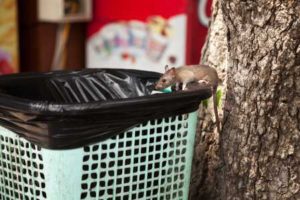RAT BURROW? OR SOMETHING ELSE?
By Zachary Ciras on March 18, 2020.
How can you tell a rat’s burrow from any other animal burrow? We’ve noticed a few holes around the edge of the concrete slab that our garbage cans sit on. Haven’t seen any rats or anything else but sometimes there is fresh dirt there.
J.B., Sandown, NH
Of course you need to have a professional take a look at the situation because, as you already know, lots of small animals nest in burrows with entrance holes. However, I regret to report that the situation you describe sounds pretty typical for rat burrows. Rats have a strong association with garbage, they like to be near it, and they like to nest under slabs or other heavy objects. (see Where Do Rats Nest?)
BURROW OPENINGS CAN OFFER CLUES
The size of a rat’s burrow opening can be diagnostic but is less clear-cut when the entrance is along the edge of a slab where the opening is more elongate than circular. A typical rat burrow opening is 2-3 inches across. A burrow that is actively used will have an opening that is free of dirt and leaves, etc. and the soil will be packed down and smooth from use. If a burrow is new or is being repaired, you can find freshly excavated dirt strewn in a fan-shape around the opening (see Could Those Be Rat Holes?).
The burrow system itself is fairly shallow, less than 18 inches deep, and less than 3 feet long. There is a nest chamber in the center. Multiple holes can be escape holes connected to the same burrow system or you can be dealing with more than one rat (or other mammal). A pest management professional may spot other signs of rats’ nesting such as droppings, footprints, a travel route with oily rub marks from the rats’ hairs, gnawing damage, etc.
Other possibilities that would need to be ruled out: chipmunks, voles, or moles. Ensure that the holes do not end in a couple of inches which means they could instead be foraging holes dug by squirrels or skunks while looking for grubs or nuts, and not burrows at all.
IT’S ALL ABOUT THE GARBAGE!
By now you’ve probably figured out that your outside garbage storage and handling is part of the problem. The garbage cans need to be relocated, at least temporarily, and probably replaced with a more rodent-proof design. Rats can chew into plastic garbage cans and lids. Replace with galvanized metal cans with tight-fitting lids.

Young rat on the brim of an open garbage container on the street. Shutterstock
Make sure garbage is first placed in a tied-off plastic bag before being placed in the can (garbage bags by themselves are not rat-proof). Try not to leave garbage outside for an extended time, and especially not overnight. Store the garbage inside or in a garage and don’t place it outside until just before collection (see Manage Food and Garbage to Manage Rats).
CALL IN THE PROFESSIONALS!
Actually, it may not be all about the garbage. Other situations will also attract rats to a yard: bird feeders, pet food left outside, accumulations of pet poop left in the yard, and rotting fruit or garden vegetables left on the ground.
Give us a call at Colonial Pest. Our experts can verify whether or not it’s rats that are occupying the holes, and if so, we have effective control measures.
For more on residential rats, see: